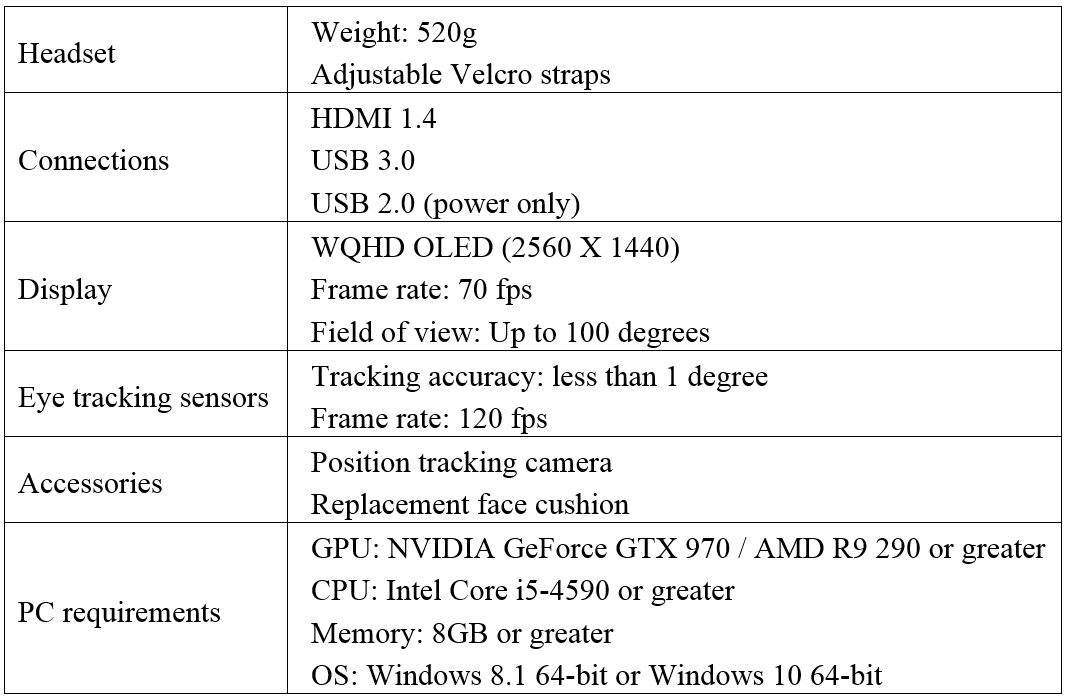The Fove headset has at last become a real product. Distinguishing features of the HMD developed by Fove, Inc. (San Mateo, CA) include eye tracking capability and the use of foveated image rendering.

Meko has been reporting on developments at Fove since the company’s inception. Subscribers to Meko newsletters interested in background information can enter “Fove” into the search engine found on the home page of the Display Daily website to obtain a listing of articles about the company. An article that I wrote in May, 2015 was entitled “Fove VR Headset is Controlled by Eye Movements.” In this article, I reported that Fove had just initiated a Kickstarter funding campaign to raise $250,000. Turns out that the campaign was quite successful. By the time the campaign closed on July 4, 2015, commitments by 1,480 backers totaled $480,650. In addition to the funds raised on Kickstarter, an undisclosed amount was reportedly invested by Samsung Ventures. In March of last year, Fove attracted an $11 million Series A investment round.
The purpose of this article is to bring readers up to date on the latest developments at Fove and provide details on the ultimate configuration and specifications of the so-called Fove 0 HMD.
The Fove 0 ultralow latency stereo eye tracking system illuminates the user’s eyes with infrared light. Several infrared ChipLEDs from Osram Opto Semiconductors are mounted around the two lenses in the headset. The model SFH 4053 LEDs are tiny, only 0.5 mm x 1.0 mm x 0.45 mm in size. The emission of the LEDs have a wavelength of 850 nm and a beam angle of +/- 70 degrees to ensure an even illumination of the eyes. An IR sensitive camera sensor is used to detect reflections from the user’s eyes. The emission wavelength of the LEDs is matched to the spectral sensitivity of the camera sensor. The information captured by the cameras is analyzed by algorithms to determine the user’s gaze direction and the movements of the user’s eyes.
Given knowledge of the user’s gaze direction, one possible application is the ability to navigate user interfaces – without the need for a separate input device.
Another feature of the Fove 0 is that the HMD uses foveated rendering. In foveated rendering, the quality of the image is optimized only at the specific area where the user is looking. The balance of the field of view is allowed to have a lower image quality. This approach reduces the computational burden associated with presenting the image and does so without reducing the quality of the image seen by the user.
The Fove 0 also uses infrared sensor technology to track the user’s position and movements. Several Osram SFH 4253 TOPLEDs are mounted around the headset. The LEDs create a pattern of infrared dots in the surrounding environment. These dots are registered and tracked by a camera to determine the user’s movements within the environment. By this means, it becomes possible to integrate an avatar of the user and the surrounding environment into the virtual reality images.
A video discussing and illustrating the Fove 0 HMD can be found at the end of his article. An illustration of the Fove 0 HMD appears in the figure below.
The Fove 0 HMD.
Some of the specifications and features of the final Fove 0 product include the following.

Fove represents that the capabilities of the Fove 0 provide a “natural focus” that “enables simulated light field rendering based on a person’s real-time field-of-view” and “creates a sense of presence and immersion.” Furthermore, by using the company’s eye tracking technology, “game developers can create genuine two-way interaction experiences in virtual worlds.”
The Fove 0 supports plugins for popular game engines Unity, Unreal and Xenko. Fove is currently preparing drivers for existing VR game titles originally developed for SteamVR and OSVR based headsets.
It might be mentioned that other major players in the HMD product space have also shown significant interest in the eye tracking/foveated image approach adopted by Fove. Two prominent instances of this interest were the purchase during June, 2017 by Apple of the eye-tracking firm SensoMotoric Instruments and the purchase by Oculus of the eye tracking/foveal technology company The Eye Tribe in December, 2016. (Oculus Acquires Eye Tribe and Apple Buys SMI to Acquire Gaze Technology – subscription required)
The Fove 0 HMD can be ordered on the company web site at a price of $599. -Arthur Berman

